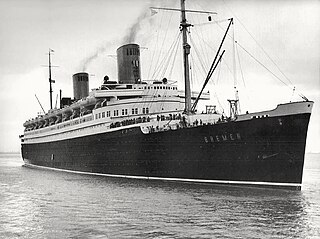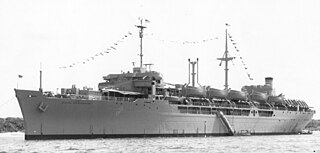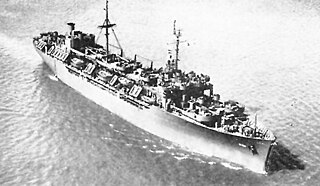Service history
General W. G. Haan conducted shakedown training out of San Diego, California, until after the surrender of Japan. Departing 4 September 1945, for the southwest Pacific, the transport touched at Eniwetok, Leyte, and Manila, before returning to Seattle, Washington, with homecoming veterans 22 October. Subsequently, the ship made two voyages to Japan and the Philippines, bringing occupation troops and embarking returning servicemen. She returned to San Francisco, California, after her last passage, and departed 30 April 1946, for the East Coast via the Panama Canal. Arriving Baltimore, Maryland, 25 May, General W. G. Haan decommissioned there 7 June 1946, and was returned to the War Shipping Administration (WSA) for further transfer to the Army Transport Service.
The General Haan departed from Bremerhaven on 5 March 1949 for New York, "with 884 passengers of whom 372 are Jewish", according to a cable (7 March 1949) from Jointfund Emigration Bremen. [4]
The General Haan was scheduled to depart on 9 April 1949 for Boston, according to a cable (11 April 1949) from Jointfund Emigration Bremen. [5]
The General Haan departed from Bremerhaven on 3 May 1949 for New York, "with 884 passengers of whom 279 are Jewish", according to a cable (4 May 1949) from Jointfund Emigration Bremen. [6]
The General Haan was scheduled to depart on 31 May 1949 for New York, according to a cable of the same date from Jointfund Emigration Bremen. [7]
The General Haan was scheduled to depart on 5 July 1949 for New York, according to a cable (30 June 1949) from Jointfund Emigration Bremen. [8]
The General Haan was scheduled to depart on 31 July 1949 for Boston, according to a cable (1 August 1949) from Jointfund Emigration Bremen. [9]
The General Haan was scheduled to depart on 22 August 1949 for New York, according to a cable of the same date from Jointfund Emigration Bremen. [10]
The General Haan was scheduled to depart on 17 September 1949 for New York, according to a cable (15 September 1949) from Jointfund Emigration Bremen. [11]
On 2 October 1949, General W. G. Haan departed Naples with 1303 displaced persons from Eastern Europe for resettlement in Australia, arriving 15 November 1949, at Melbourne. On 18 December 1949, she left Bremerhaven arriving 28 December, in New York City with mostly Polish passengers. She completed another voyage to Melbourne on 21 February 1950, with 1301 more refugees.
Reacquired by the Navy 1 March 1950, General W. G. Haan was assigned to Military Sea Transportation Service (MSTS) under a civilian crew. Until 1953, she operated under the International Refugee Organization and carried displaced East Europeans from northern European ports to the United States. In 1952, General W. G. Haan also made two support voyages to the American bases at Thule, Greenland, and Goose Bay, Labrador. Following this demanding duty, the ship made several voyages to Europe in support of American units. She continued this steaming schedule until March 1955, when she was placed in Reduced Operational Status at New York.
In December 1956, General W. G. Haan resumed duty as a refugee transport, steaming from Bremerhaven to New York, and arriving on 7 January 1957. She embarked refugees from the Hungarian Revolution, among them, András István Gróf, who would eventually take the helm of Intel Corporation. [14] General W. G. Haan was again placed in Reduced Operational Status in the Atlantic Reserve Fleet, Orange, Orange, Texas, and was returned to the Maritime Administration (MARAD) 22 October 1958. She entered the National Defense Reserve Fleet for layup at nearby Beaumont.

SS Bremen was a German-built ocean liner constructed for the Norddeutscher Lloyd line (NDL) to work the transatlantic sea route. Bremen was notable for her bulbous bow construction, high-speed engines, and low, streamlined profile. At the time of her construction, she and her sister ship Europa were the two most advanced high-speed steam turbine ocean liners of their day. The German pair sparked an international competition in the building of large, fast, luxurious ocean liners that were national symbols and points of prestige during the pre-war years of the 1930s. She held the Blue Riband, and was the fourth ship of NDL to carry the name Bremen.

SS Europa, later SS Liberté, IMO 5607332, was a German ocean liner built for the Norddeutsche Lloyd line (NDL) to work the transatlantic sea route. She and her sister ship, Bremen, were the two most advanced, high-speed steam turbine ocean vessels in their day, with both earning the Blue Riband.
Norddeutscher Lloyd was a German shipping company. It was founded by Hermann Henrich Meier and Eduard Crüsemann in Bremen on 20 February 1857. It developed into one of the most important German shipping companies of the late 19th and early 20th centuries, and was instrumental in the economic development of Bremen and Bremerhaven. On 1 September 1970, the company merged with Hamburg America Line (HAPAG) to form Hapag-Lloyd AG.

USS Admiral W. S. Sims (AP-127) was a transport in the United States Navy. She was later renamed USNS General William O. Darby (T-AP-127). Later her name was struck and she was known simply by her hull number. In 1981, she was reclassified as IX-510.

USS General A. W. Greely (AP-141) was a General G. O. Squier-class transport ship named for U.S. Army general Adolphus Greely. She was transferred to the U.S. Army as USAT General A. W. Greeley in 1946. On 1 March 1950 she was transferred to the Military Sea Transportation Service (MSTS) as USNS General A. W. Greely (T-AP-141). She was later sold and converted to a container ship and operated under several names before being scrapped in 1986.

USS Admiral Hugh Rodman (AP-126) was an Admiral W. S. Benson-class transport: Laid down, 24 April 1944, as a Maritime Commission type (P2-SE2-R1) hull, under Maritime Commission contract,, at Bethlehem Shipbuilding Corporation, Alameda, California; launched on 25 February 1945; commissioned as the USS Admiral Hugh Rodman (AP-126), 7 July 1945, decommissioned on 14 May 1946, at New York; transferred to the U.S. Army Transportation Service in May 1946; commissioned USAT General Maurice Rose on 1 August 1946; reacquired by the U.S. Navy and assigned to the Military Sea Transport Service (MSTS); placed in service as USNS General Maurice Rose (T-AP-126) on 1 March 1950.

USS General Stuart Heintzelman (AP-159) was a General G. O. Squier-class transport ship for the U.S. Navy in World War II. She was named in honor of U.S. Army general Stuart Heintzelman. She was transferred to the U.S. Army as USAT General Stuart Heintzelman in 1946. On 1 March 1950 she was transferred to the Military Sea Transportation Service (MSTS) as USNS General Stuart Heintzelman (T-AP-159). She was later sold for commercial operation before being scrapped in 1984.

USS General LeRoy Eltinge (AP-154) was a General G. O. Squier-class transport ship for the US Navy in World War II. She was named in honor of US Army general LeRoy Eltinge. She was transferred to the US Army as USAT General LeRoy Eltinge in 1946. On 20 July 1950 she was transferred to the Military Sea Transportation Service (MSTS) as USNS General LeRoy Eltinge (T-AP-154). She was later sold for commercial use and operated under the names SS Robert E. Lee and SS Robert Toombs, before being scrapped in 1980.

USS General R. M. Blatchford (AP-153) was a General G. O. Squier-class transport ship for the U.S. Navy in World War II. She was named in honor of U.S. Army general Richard M. Blatchford. She was transferred to the U.S. Army as USAT General R. M. Blatchford in 1946. On 1 March 1950 she was transferred to the Military Sea Transportation Service (MSTS) as USNS General R. M. Blatchford (T-AP-153). She was later sold for commercial operation under the names SS Stonewall Jackson and Alex Stephens, before being scrapped in 1980.

USS General W. M. Black (AP-135) was a General G. O. Squier-class transport ship for the U.S. Navy in World War II. The ship was crewed by the U.S. Coast Guard until decommissioning. She was named in honor of U.S. Army general William Murray Black. She was transferred to the U.S. Army as USAT General W. M. Black in 1946. On 1 March 1950 she was transferred to the Military Sea Transportation Service (MSTS) as USNS General W. M. Black (T-AP-135). She was later sold for commercial operation under the name SS Green Forest, before being scrapped in 1980.

USS General S. D. Sturgis (AP-137) was a General G. O. Squier-class transport ship for the U.S. Navy in World War II. She was named in honor of U.S. Army general Samuel Davis Sturgis. She was transferred to the U.S. Army as USAT General S. D. Sturgis in 1946. On 1 March 1950 she was transferred to the Military Sea Transportation Service (MSTS) as USNS General S. D. Sturgis (T-AP-137). She was later sold for commercial operation under the name SS Green Port, before being scrapped in 1980.

USS General M. B. Stewart (AP-140) was a General G. O. Squier-class transport ship for the U.S. Navy in World War II. She was named in honor of U.S. Army general Merch Bradt Stewart. She was transferred to the U.S. Army as USAT General M. B. Stewart in 1946. On 1 March 1950 she was transferred to the Military Sea Transportation Service (MSTS) as USNS General M. B. Stewart (T-AP-140). She was later sold for commercial operation under the name SS Albany, before being scrapped in July 1987.

USS General C. H. Muir (AP-142) was a General G. O. Squier-class transport ship for the U.S. Navy in World War II. The ship was crewed by the U.S. Coast Guard until decommissioning. She was named in honor of U.S. Army general Charles Henry Muir. She was transferred to the U.S. Army as USAT General C. H. Muir in 1946. On 1 March 1950 she was transferred to the Military Sea Transportation Service (MSTS) as USNS General C. H. Muir (T-AP-142). She was later sold for commercial operation under the names SS Chicago and SS San Juan, and was scrapped some time after 1985.

USS General M. L. Hersey (AP-148) was a General G. O. Squier-class transport ship of the U.S. Navy in World War II. She was named in honor of U.S. Army general Mark Leslie Hersey. She was transferred to the U.S. Army as USAT General M. L. Hersey in 1946. On 1 March 1950 she was transferred to the Military Sea Transportation Service (MSTS) as USNS General M. L. Hersey (T-AP-148). She was later sold for commercial use, and operated under the names SS Pittsburgh and SS St. Louis.

USS General W. C. Langfitt (AP-151) was a General G. O. Squier-class transport ship for the U.S. Navy in World War II. She was named in honor of U.S. Army general William Campbell Langfitt. She was transferred to the U.S. Army as USAT General W. C. Langfitt in 1946. On 1 March 1950 she was transferred to the Military Sea Transportation Service (MSTS) as USNS General W. C. Langfitt (T-AP-151). She was later sold for commercial operation under the name SS Transindiana, before ultimately being scrapped in 1983.

USS General W. A. Mann (AP-112) was a troop transport that served with the United States Navy in World War II, the Korean War and the Vietnam War.

USS General H. W. Butner (AP-113), named for Henry W. Butner, was a troopship that served with the United States Navy in World War II and the Korean War. She was redesignated T-AP-113 in October 1949.

Bremerhaven is a city at the seaport of the Free Hanseatic City of Bremen, a state of the Federal Republic of Germany.

USS Admiral E. W. Eberle (AP-123) was laid down on 15 February 1943 under a Maritime Commission contract by the Bethlehem Shipbuilding Corporation, Alameda, California; launched on 14 June 1944; sponsored by Mrs. Earl Warren, the wife of the Governor of California who later became Chief Justice of the United States Supreme Court; and acquired by the Navy and commissioned on 24 January 1945.
USNS Marine Carp (T-AP-199) was a Marine Adder-class transport that saw service with the US Navy for the task of transporting troops to and from combat areas. She was of the C4-S-A3 design type.


















